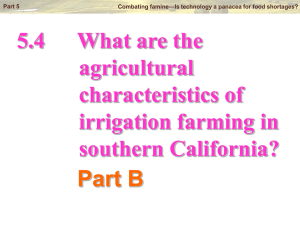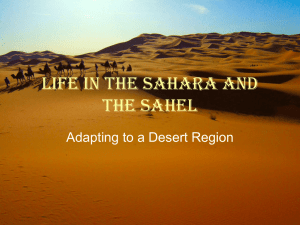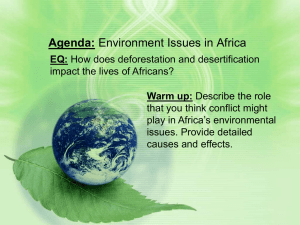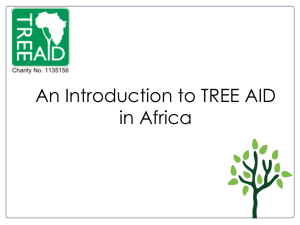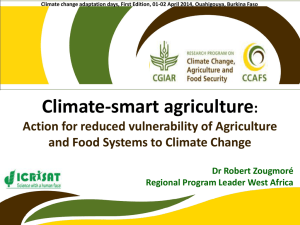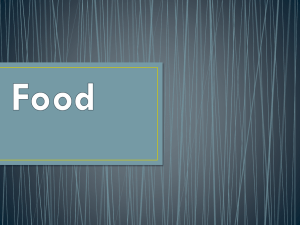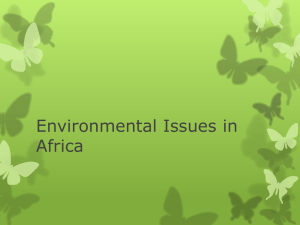Famine 4
advertisement
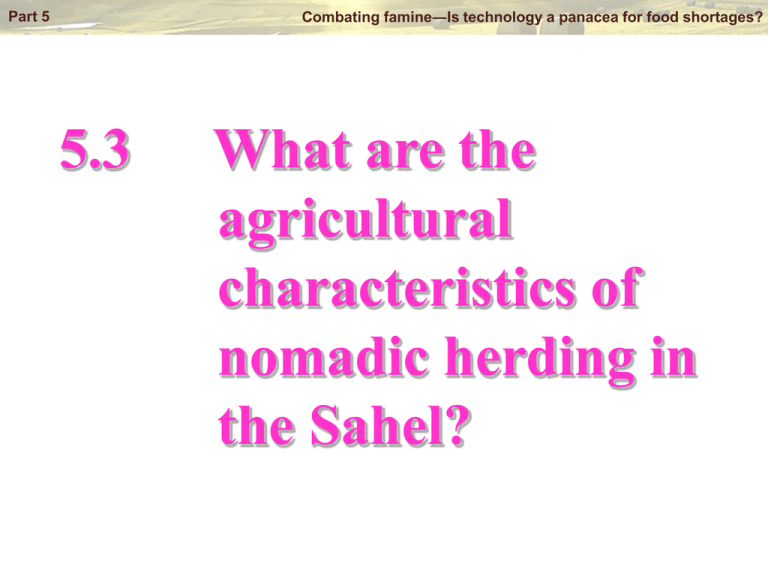
Combating famine―Is technology a panacea for food shortages? Part 5 5.3 © Oxford University Press 2009 What are the agricultural characteristics of nomadic herding in the Sahel? Combating famine―Is technology a panacea for food shortages? Part 5 Where is the Sahel? The Sahel is a belt of semi-arid land at the ( northern / southern ) edge of the Sahara Desert in Africa. The Sahel separates the Sahara Desert to the north and the savanna to the south Mauritania Senegal Mali Burkina Faso Niger Chad Sudan Eritrea Nigeria Ethiopia Somalia It lies approximately between 11°N and 20°N. It stretches across many countries. © Oxford University Press 2009 Combating famine―Is technology a panacea for food shortages? Part 5 What is the physical environment of the Sahel? 1 Climate Describe the temperature and rainfall patterns of Zinder, a city in the Sahel. Zinder Its annual mean temperature reaches 28°C. 10°C Annual mean temperature: 28C Its annual range of temperature is around ____°C. 10 It is ( cold / hot ) throughout the year. © Oxford University Press 2009 Combating famine―Is technology a panacea for food shortages? Part 5 What is the physical environment of the Sahel? What kind of 1 Climate climate does the Sahel have? Zinder Its annual rainfall is ( low / high ), about 471 mm. Annual rainfall: 471 mm Most rain falls between _______ July and ________, August which are the ( summer / winter ) months in the Northern Hemisphere. The Sahel has a ( tropical / polar ) ( arid / semi-arid / humid ) climate. © Oxford University Press 2009 Combating famine―Is technology a panacea for food shortages? Part 5 What is the physical environment of the Sahel? 1 Climate © Oxford University Press 2009 Why it is dry in the Sahel? Combating famine―Is technology a panacea for food shortages? Part 5 What is the physical environment of the Sahel? How would you 1 Climate The rainfall in the Sahel is ( constant / variable ) and ( reliable / unreliable ). It may be wet in one year and then very dry in other years describe the rainfall pattern of the Sahel? Variability in rainfall averages from June to October in the Sahel, 1950-2004 Source: JISAO (A joint institute between the University of Washington and the NOAA) © Oxford University Press 2009 Combating famine―Is technology a panacea for food shortages? Part 5 What is the physical environment of the Sahel? 2 Drainage and relief Niger Much The River of the _______ Sahel has and athe ( low / River______ high ) Nile relief, drain the Sahel. except the eastern However, cover only a part wherethey highlands in Sudan relative smallare area. and Ethiopia found. © Oxford University Press 2009 Combating famine―Is technology a panacea for food shortages? Part 5 What is the physical environment of the Sahel? 3 Soils and vegetation Thin and infertile brown soils Strong insolation leading to a high evaporation rate ___________ What environmental Little Insufficient factors contribute organic soil moisture matter to this? Limits vegetation growth © Oxford University Press 2009 Although the plants may dry In the Sahel, the natural up, they can still hold the grassland vegetation are __________ topsoil and prevent it from and ________ shrubs being blown away by strong winds Vegetation cover in the Sahel Combating famine―Is technology a panacea for food shortages? Part 5 How do people in the Sahel make a living? Most In areas people where practise conditions for ________________. cultivation are more nomadic herding favourable, some people may They rear livestock and move grow crops such peanuts from one place toas another to and lookmillet. for ______ water and ________. pasture Moving to another spot © Oxford University Press 2009 Grazing of livestock around water spots Pasture and water exhausted Combating famine―Is technology a panacea for food shortages? Part 5 What is the nomadic herding system in the Sahel? Inputs What are Farming the processes characteristics of 1 Moving the herds in this farming system? search of water and pasture Physical inputs 1 Climate • Strong solar radiation 2 Watering • Annual rainfall 200-600 mm. It is 3 Milking unreliable 4 Mating ( Arable farming / Livestock rearing ) 2 Infertile brown soil 5 Processing dairy products 3 Vegetation cover/ Extensive ) farming ( Intensive • Shrubs and grassland ( Subsistence / Commercial ) farming Outputs 4 Herds Milk, meat, hides ( Low-technology / High-technology ) farming Cultural inputs 1 Labour ( Sedentary / Non-sedentary ) farming • Mainly for subsistence use 2 Simple and traditional technology • A small part for sale 3 Little energy input © Oxford University Press 2009 Combating famine―Is technology a panacea for food shortages? Part 5 What are the farming constraints in the Sahel? Farming constraints Physical constraints Water shortages © Oxford University Press 2009 Infertile soil Cultural constraints A low level of technology Poverty Combating famine―Is technology a panacea for food shortages? Part 5 What are the farming constraints in the Sahel? Low carrying capacity The maximum size of population that the available resources can support is called the _________________ carrying capacity of the land. Just reached carrying capacity © Oxford University Press 2009 Part 5 Combating famine―Is technology a panacea for food shortages? What are the farming constraints in the Sahel? Low carrying capacity In the Sahel, the carrying capacity is ( low / high ). It is 0.2 to 0.7 household per square kilometre © Oxford University Press 2009 Combating famine―Is technology a panacea for food shortages? Part 5 How do the nomads in the Sahel adapt to the environment? 1 Migration of herds/Transhumance What are the advantages of transhumance? The old patch can be left fallow for grass to grow again. The ecological balance can be maintained. © Oxford University Press 2009 Herds are moved to another site Herds are moved to another site Herds are grazed at a when the pasture is exhausted the pasture is exhausted Thewhen herds return oldspot site again site nearto a the water Combating famine―Is technology a panacea for food shortages? Part 5 How do the nomads in the Sahel adapt to the environment? 2 Keeping a variety of animal species Different types of animals What are the advantages eat different types of plants: of keeping such a Herds Food required variety of animal species? Camel The branches and leaves of trees and Nomads The various cananimal make good species shrubs use can of provide different nomads plant with a 10 Goat The of trees species rich mix in ofleaves the dairy pasture. products camels and shrubs at different times. It prevents any one Sheep Grass particular plant species Cattle Grassexhausted. from being © Oxford University Press 2009 10–12 donkeys 25–30 cattle 100 small goats and sheep Combating famine―Is technology a panacea for food shortages? Part 5 How do the nomads in the Sahel adapt to the environment? 3 Controlling the number of animals in the herd With adequate rainfall and favourable vegetation conditions With inadequate rainfall or drought Reduce the size of the herd © Oxford University Press 2009 The thorny plants and rough grasses can grow What are well. reasonably the The ecological advantages? balance can be maintained. Combating famine―Is technology a panacea for food shortages? Part 5 What has happened to the Sahel in recent years? What impact does desertification degradation Environmental ____________ has have on the and livestock been happening in people this area. in the area? The amount of natural vegetation is decreasing. The poor environment can only support and The soil aisvery poorlow andpopulation soil _______ erosion a herds. isfew serious. hunger The herds may die of ________. _____________ Desertification occurs and the Food shortages may result in land becomes unproductive. hunger and famine among people. (Credit: Eddy Posthuma de Boer/International Federation of Red Cross and Red Crescent Scene in the Sahel in recent Societies) years © Oxford University Press 2009 Part 5 Combating famine―Is technology a panacea for food shortages? What has gone wrong? Is nature causing problems? Pasture decreases There are no more pasture and water. Herds die Unreliable rainfall Nomads move in search of water and pasture © Oxford University Press 2009 Prolonged drought Vegetation cannot regenerate. Pasture and water are used up Combating famine―Is technology a panacea for food shortages? Part 5 What has gone wrong? Are humans causing problems? 1 Increase in population Population in the four selected countries in the Sahel Population (2006) (million) Population Birth rate growth (2008) (per (2006) 1,000 people) Mali 12 3% 48 Niger 13.7 3.5% 46 Chad 10.5 3.1% 44 Ethiopia 77.2 2.6% 40 0.7% 12 More developed countries (Source: World Development Indicators database, the World Bank/2008 World Population Data Sheet, Population Reference Bureau) In the Sahel, there is a ( slow / rapid ) population growth and ( low / high ) birth rates. © Oxford University Press 2009 Combating famine―Is technology a panacea for food shortages? Part 5 What has gone wrong? Are humans causing problems? 1 Increase in population The rapid rate of increase in population adds pressure These lead to: on the land. Number of Carrying capacity Further land This leads to > the following people of the landpractices: degradation A Converting grazing land to farmland © Oxford University Press 2009 B Reducing fallowing periods C Overgrazing Combating famine―Is technology a panacea for food shortages? Part 5 What has gone wrong? Are humans causing problems? 2 Misuse of water resources Local governments in the Sahel want the nomads to become sedentary pastoralists in order to get taxes from With Water more water supply, and pasture Water in this them.What people rear animals People area dig wells notmore enough for is used up are Pasture problems will and boreholes thenomads large herd decreases Staying in the same place permanently, the occur if with the problem of water supply. Many need to deal nomads stay local governments dig boreholes to tap water from in the same underground. place for living? Water table drops © Oxford University Press 2009 Combating famine―Is technology a panacea for food shortages? Part 5 Physical constraints of farming in the Sahel Water shortages Rainfall is inadequate, with an annual total of 200-600 mm. Drought is common. There are no large rivers in the region. It makes the development of irrigation systems difficult. Infertile soil Sub-arid brown soil is thin and infertile. It is easily eroded. There is sparse vegetation and pastureland. © Oxford University Press 2009 Combating famine―Is technology a panacea for food shortages? Part 5 Cultural constraints of farming in the Sahel A low level of technology The main human input is ( labour / machinery ). There is little energy input in terms of machines, irrigation, fertilizers and pesticides. The yield is low. Poverty Both the people and the country are poor. They do not have the money to improve the physical environment through cultural inputs. © Oxford University Press 2009 Combating famine―Is technology a panacea for food shortages? Part 5 A Converting grazing land to farmland More of the land formerly used for pasture is being used for growing crops in order to feed the increasing population. What Infertile soil problem does it cause? Crops absorb particular nutrients Put further pressure on the already poor soil © Oxford University Press 2009 A farmer working on a peanut field in Senegal (Credit: Vince Streano/Corbis) Combating famine―Is technology a panacea for food shortages? Part 5 B Reducing fallowing periods In order to produce more food, farmers in the Sahel have reduced the fallowing periods of fields. Fallowing Fallowing © Oxford University Press 2009 This causes depletion of soil nutrients. Soil erosion and degradation environmental ___________ are worsened. Combating famine―Is technology a panacea for food shortages? Part 5 C Overgrazing Nomads have been rearing more livestock because the rapid increase in population puts pressure on producing more food; cattle can be sold to Sheep drinking at a water hole in the Sahel (Credit: FAO [18781/I.Balderi]) cities and distant markets since 1. Pastureland does not have transport has improved. enough time to recover. be of herds 2. TheWhat largewould number resulted from will _______ and destroy the trample rearing thin soil. more herds? © Oxford University Press 2009

